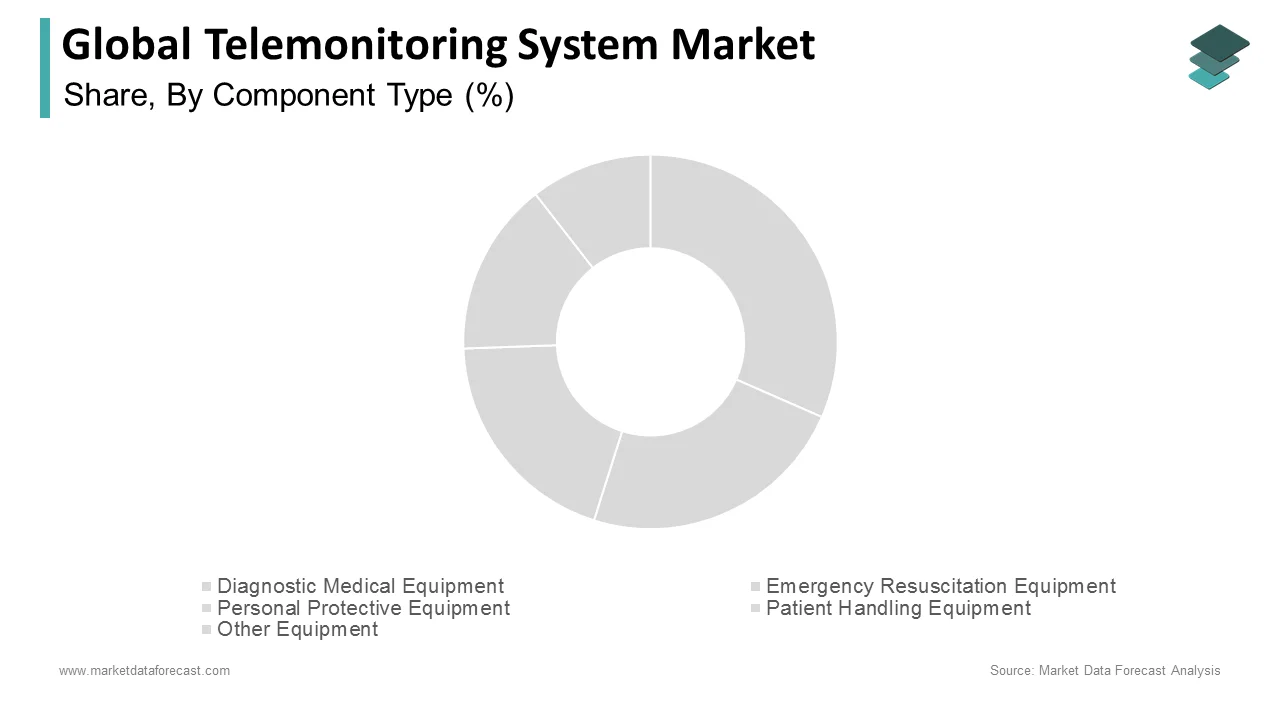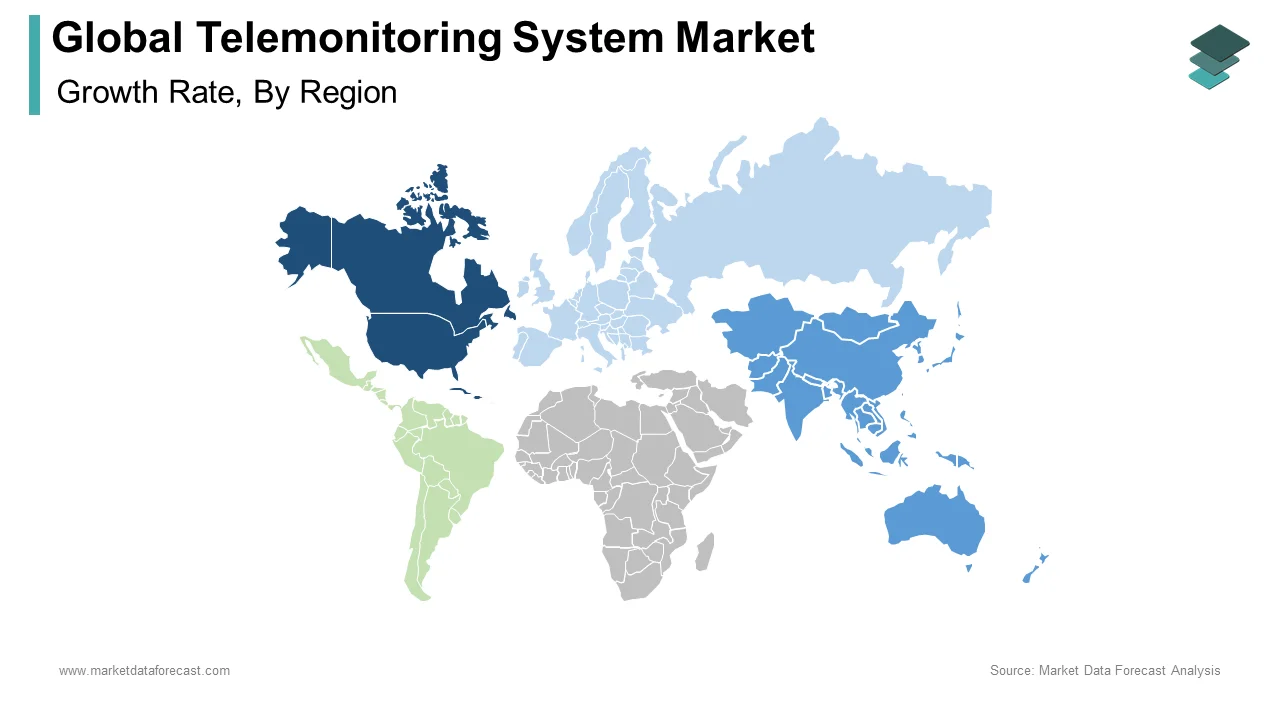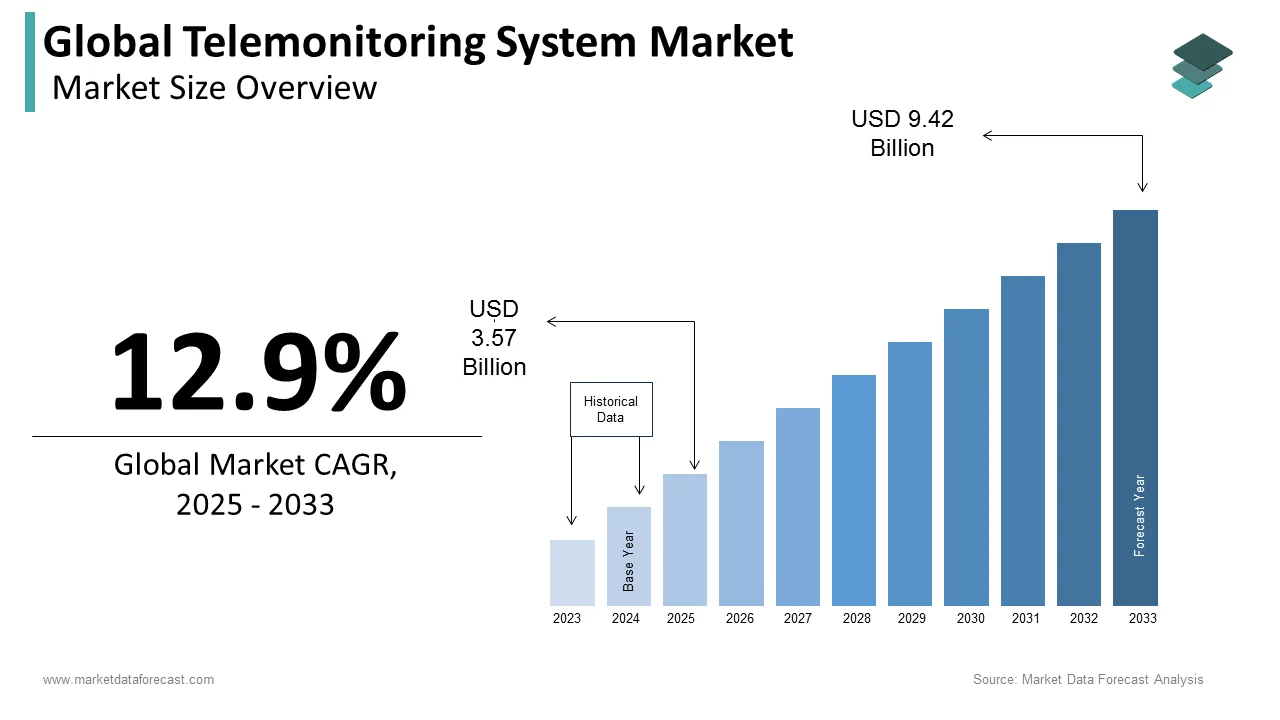Global Telemonitoring System Market Size, Share, Trends & Growth Forecast Report By Product Type (Remote Glucose Level Monitoring Systems, Remote COPD Monitoring Systems, Remote Cardiac Monitoring Systems, Remote Blood Pressure Monitoring Systems and Others), End-User and Region (North America, Europe, Asia-Pacific, Latin America, Middle East and Africa), Industry Analysis From 2025 To 2033.
Global Telemonitoring System Market Size
The size of the global telemonitoring system market was worth USD 3.16 billion in 2024. The global market is anticipated to grow at a CAGR of 12.9% from 2025 to 2033 and be worth USD 9.42 billion by 2033 from USD 3.57 billion in 2025.
MARKET DRIVERS
One of the most relevant factors boosting the growth of the telemonitoring system market is the rising global incidence of chronic diseases.
As there is a rapidly changing lifestyle of individuals and also due to physical inactivity, unhealthy dietary habitat, and growing burden of risk factors such as tobacco use and obesity, the chances of chronic conditions arising are higher; many people globally suffer from chronic diseases. Globally, 58% of people suffer from hypertension, cholesterol, and diabetes, and 38% of people suffer from chronic kidney diseases and arthritis. Thus, there is a rising demand for telemonitoring services such as telehealth, telemedicine for remote patient monitoring, and counseling. This system enables healthcare professionals to remotely monitor patients’ health parameters such as blood pressure, heart rate, glucose level, and respiratory function. It also enhances early detection of deteriorating health conditions, reduces hospital readmission, improves the overall patient outcome, promotes self-management, and empowers the patient to actively participate in their care; thus, these factors boost the growth of the market during the projected period.
Another major factor fueling the market's growth is the government initiative to promote telehealth. The government establishes certain policies and regulations that facilitate the integration of telemonitoring systems into the healthcare system, including creating standards for data privacy and security and defining reimbursement policies for telehealth services. The government also provides certain funds to healthcare organizations to adopt telehealth solutions. The government also invests in the development of telehealth infrastructure, including broadband connectivity in remote and underserved areas and reliable and high-speed internet connections crucial for the implementation of a system to enable real-time data transmission and remote communication between patients and healthcare providers. Also, it is a time-saving system; hence, the market generates more revenue by adopting the telemonitoring system.
The third crucial factor that favors market growth is the rising geriatric population. As there is a vastly rising population, the need for emergency medical services is emerging.
Due to the aging population, people are more prone to developing chronic diseases such as cardiovascular conditions, diabetes, respiratory disorders, and hypertension. Telemonitoring systems enable healthcare providers to manage their chronic conditions more effectively. Also, this system allows for continuous monitoring of vital signs and can alert healthcare professionals to any concerning changes; the geriatric population often requires frequent medical appointments, leading to increased healthcare costs; the telemonitoring system can help to reduce healthcare expenses by minimizing hospital visits; thus, this factor favors the market growth during the projected period.
The other factor that propels the market growth is technological advancement, rising consumer preference towards adequate monitoring at home and reducing the number of hospitalizations, rising incidences of non-communicable diseases such as Alzheimer’s disease, cardiovascular disease, diabetes, cancer, increasing patient preference towards continent health monitoring, emerging research and development activities boosting the growth of the market during the forecasted period.
MARKET RESTRAINTS
Although many factors are propelling the growth of the telemonitoring system market, some factors could restrain that market's expansion throughout the forecast period. Trust and privacy concern about medical information is a major issues that constrained the growth of the market. The implementation of the telemonitoring system is constrained by issues like the need to build the trust of care, and professionals who are not physically present. The complexity of technology, and privacy concern about medical information, restrict the market growth. If the patient experiences dementia and sensory impairment, communicating with distant clinicians will be challenging and impact the market growth. The other factor hampering the growth of the market is a lack of trained professionals in rural regions, privacy, and information security concern and low availability of telecommunication bandwidth are the major factor hampering the growth of the telemonitoring system market.
Impact Of Covid-19 On The Telemonitoring System Market
The sudden outbreak of the pandemic had hampered every sector of the globe. Every sector of the world had faced certain issues due to disruptions in the supply chain, restrictions on production because of social isolation, lockdowns, and social distance, the whole world fight against the pandemic due to the rising burden on hospital and healthcare professionals, however, this has also opened new opportunities in the digital health platforms such as telemonitoring system. A growing number of people are adopting digital technologies like telehealth for remote patient monitoring, electronic health records, and telemedicine platforms for delivering medication like pharmacies, as well as various platforms to provide healthcare services, as there were approximately 503 million confirmed cases of COVID-19 during the pandemic and 6.3 million deaths globally, which increased the burden on healthcare facilities. Due to the large range of digital tools created in response to the increase in demand for remote patient monitoring and counseling, the telemonitoring system market experienced growth during times of crisis. Rapid information dissemination to healthcare professionals was crucial throughout the pandemic for treatment. The pandemic demonstrated the significance of modern technologies, including telemedicine and electronic health records (EHR), as dependable and scalable solutions in case of medical emergencies. Cloud computing technology aids healthcare organizations in monitoring, diagnosing, testing, and consulting clinical operations.The pandemic produced a significant amount of healthcare data about COVID-19 testing, contact tracing, and vaccine distribution the tools such as cloud computing provided scalable storage solutions and potent processing capabilities to handle the increased data volume and allowed healthcare professionals and researchers to analyze and gain insight from the data effectively. As more benefits are associated with the telemonitoring system it boosts the demand in the market during the crisis and will continuously boost the growth of the market in upcoming years.
REPORT COVERAGE
|
REPORT METRIC |
DETAILS |
|
Market Size Available |
2024 to 2033 |
|
Base Year |
2024 |
|
Forecast Period |
2025 to 2033 |
|
CAGR |
12.9% |
|
Segments Covered |
By Component Type, Application, and Region. |
|
Various Analyses Covered |
Global, Regional, and country-level analysis; Segment-Level Analysis, DROC; PESTLE Analysis; Porter’s Five Forces Analysis, Competitive Landscape; Analyst Overview of Investment Opportunities |
|
Regions Covered |
North America, Europe, APAC, Latin America, Middle East & Africa |
|
Market Leaders Profiled |
Abbott Laboratories, Allscripts Healthcare Solutions Inc., AMD Global Telemedicine, Inc., Cisco Systems, Inc., Care Innovations LLC, General Electric Company, Honeywell Life Care Solutions, InTouch Health, Koninklijke Philips N.V., McKesson Corporation, Medvivo Group Ltd., Medtronic Plc, Nihon Kohden, Siemens Healthineers AG, Comarch SA, Tunstall Healthcare Group Ltd, and Vidyo, Inc., and Others. |
SEGMENTAL ANALYSIS
By Component Type Insights

Based on component type, the diagnostic medical equipment segment held the largest market share in 2024 and is anticipated continuously dominate the market during the projected period. This segment enables the early detection and diagnosis of health conditions by continuously monitoring vital signs such as blood pressure, heart rate, and oxygen saturation, this early detection allows for better management of chronic diseases leading to improved patient outcomes. This system also collects and transmits data in real-time to healthcare providers, allowing them to remotely assess patients’ health, this segment also improves patient convenience and is cost-effective thus this segment is anticipated to boost the market growth during the projected period.
Personal protective equipment is another segment anticipated to dominate the market during the projected period. This equipment plays a critical role in infection control, especially during telemonitoring interactions that involve close contact or physical proximity between healthcare professionals and patients. It is also crucial in ensuring compliance with safety standards and regulations in healthcare settings the use of personal protective equipment in telemonitoring become even more critical during this period to protect healthcare professionals and prevent the transmission of infectious diseases thus this segment is also anticipated to dominate the market during the projected period.
By Application Insights
Based on application, the Glucose monitoring segment held a 35% market share and is anticipated continuously dominate the market at the fastest CAGR during the projected period. The increasing prevalence of diabetes worldwide is a significant market driver for glucose monitoring in telemonitoring systems. Globally 422 million suffer from a diabetic condition, this chronic condition requires regular monitoring of blood glucose levels. Telemonitoring system enables an individual with diabetes to track their glucose level remotely, this enhances disease management, enables timely intervention, and also improves overall glycemic control thus this segment boosts the market growth during the forecasted period.
Cardiovascular disease monitoring is another segment anticipated to dominate the market at a significant CAGR during the projected period. Globally 590 million people suffer from cardiovascular diseases including heart disease and stroke which is the leading cause of morbidity and mortality worldwide. The telemonitoring system enables healthcare professionals to remotely monitor patients with cardiovascular conditions and facilitate regular tracking of their vital signs such as blood pressure, heart rate, and oxygen saturation from the comfort of their home thus this segment is anticipated to dominate the market during the projected period.
REGIONAL ANALYSIS

Geographically, the North American continent is anticipated to lead the market. The North American market is anticipated to reach US$ 20.5 billion by 2033 and grow at a CAGR of over 24% from 2025 to 2033. Telemedicine usage and remote patient monitoring rose in the USA. This figure is projected to increase to 75.6 million by 2033. The growth rate of the North American market is being driven by an increase in data-driven healthcare initiatives and the use of digital healthcare technology. Thus this segment is anticipated to dominate the market in this region.
Asia-Pacific is the second-largest region anticipated to dominate the market during the projected period. As there is a rising prevalence of chronic conditions such as diabetes, and cancer due to the increasing geriatric population which needs remote patient monitoring in this region. The expanding use of digital health solutions in Asia, the modernization of the Chinese healthcare system, and the rapidly expanding healthcare sector in India rapidly fueling the market growth in this region.
Europe is another region anticipated to grow at the fastest CAGR during the projected period. One of the key factors boosting the development of the European Telemonitoring system market is the quickening acceptance of healthcare technology in European nations. By 2033, the market is anticipated to be worth 31.7 billion. Investments in modernizing healthcare infrastructure are increasing, which helps the European market expansion.
Latin-America region is also anticipated to dominate the market during the projected period. Rising chronic disease burden, improving healthcare infrastructure, and rising awareness among people regarding digital health services contribute to the overall growth of the market during the projected period.
The Middle East and Africa region is also anticipated to grow at a significant CAGR and generate more market revenue during the projected period.
KEY MARKET PLAYERS
The prominent key player in the telemonitoring system market are Abbott Laboratories, Allscripts Healthcare Solutions Inc., AMD Global Telemedicine, Inc., Cisco Systems, Inc., Care Innovations LLC, General Electric Company, Honeywell Life Care Solutions, InTouch Health, Koninklijke Philips N.V., McKesson Corporation, Medvivo Group Ltd., Medtronic Plc, Nihon Kohden, Siemens Healthineers AG, Comarch SA, Tunstall Healthcare Group Ltd, and Vidyo, Inc. majorly contributed to the overall growth of the market.
RECENT MARKET DEVELOPMENTS
-
In March 2022, MASI recently announced a major expansion of its leading hospital remote patient-monitoring and clinician notification platform Masimo Patient SafetyNet. The expansion includes the addition of secure telehealth capabilities, thereby making the solution more adaptable and comprehensive.
-
In April 2020, In order to introduce a cloud-based COVID-19 patient monitoring software for health systems, GE Healthcare expanded its long-standing partnership with Microsoft. The programed is made to give hospital workers a central location to monitor patients in intensive care units, particularly those who are receiving medical ventilation.
- In March 2020, Sparrow Health System and Amwell, a supplier of telemedicine services, collaborated to produce a COVID-19 virtual care screening digital app in response to growing concerns around the coronavirus (COVID-19) and when to seek medical attention. You can use a computer, tablet, or smartphone to access the new software.
MARKET SEGMENTATION
The Research Report on the telemonitoring system market has been segmented and sub-segmented into component type, application, and region.
By Component Type
- Diagnostic Medical Equipment
- Emergency Resuscitation Equipment
- Personal Protective Equipment
- Patient Handling Equipment
- Other Equipment
By Application
- COPD
- Blood Pressure Monitoring
- Glucose Monitoring
- Cardiovascular Disease Monitoring
- Other Applications
Region
- North America
- Latin America
- Europe
- Asia-Pacific
- Middle East and Africa
Frequently Asked Questions
How big is the global telemonitoring system market?
The global telemonitoring system market size was valued at USD 3.16 billion in 2024.
Which region will lead the telemonitoring system market in the future?
During the forecast period, the North American region is predicted to play the leading role in the global market.
Does this report include the impact of COVID-19 on the telemonitoring system market?
Yes, we have studied and included the COVID-19 impact on the global telemonitoring system market in this report.
Who are leading companies in the telemonitoring system market?
Allscripts Healthcare Solutions Inc., Abbott Laboratories, Cisco Systems, Inc., AMD Global Telemedicine, Inc., General Electric Company, Care Innovations LLC, InTouch Health, Honeywell Life Care Solutions, McKesson Corporation., Koninklijke Philips NV, Medtronic Plc and Medvivo Group Ltd are some of the notable companies in the telemonitoring system market.
Related Reports
Access the study in MULTIPLE FORMATS
Purchase options starting from $ 2500
Didn’t find what you’re looking for?
TALK TO OUR ANALYST TEAM
Need something within your budget?
NO WORRIES! WE GOT YOU COVERED!
Call us on: +1 888 702 9696 (U.S Toll Free)
Write to us: [email protected]

